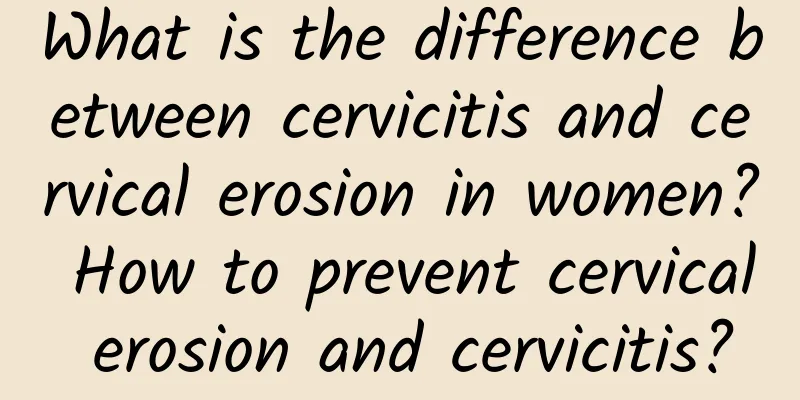What is the difference between cervicitis and cervical erosion in women? How to prevent cervical erosion and cervicitis?

|
In life, cervical erosion is the "darling" of female gynecological diseases, and cervicitis is also a common disease in women of childbearing age. Many people cannot tell the difference between cervical erosion and cervicitis, and mistakenly think that the two are the same disease. In fact, there are two types of cervicitis: acute and chronic. Chronic is more common in clinical practice. Cervical erosion is a manifestation of chronic cervicitis. What are the obvious differences in the pathogenesis and symptoms of cervicitis and cervical erosion? Is cervicitis the same as cervical erosion? Cervicitis is not necessarily cervical erosion, but incomplete treatment of acute cervicitis can lead to cervical erosion. In addition to affecting women's pregnancy, cervicitis may also cause cancer. Therefore, it is recommended that patients choose a regular hospital for thorough treatment as soon as possible. Cervical erosion is different from cervicitis. Cervical erosion is a manifestation of chronic cervicitis. Cervicitis is medically divided into acute cervicitis and chronic cervicitis. Improper or incomplete treatment of acute cervicitis may lead to chronic cervicitis. Chronic cervicitis is the most common type of inflammation of the female reproductive organs, with a high incidence rate, accounting for more than half of married women. The difference between cervicitis and cervical erosion 1. Different clinical symptoms The main symptom of cervicitis is increased vaginal discharge. Due to different pathogens, the scope and degree of inflammation, the vaginal discharge can be milky white mucus, or light yellow purulent, sometimes bloody or bleeding after sex. When the inflammation spreads to the pelvic cavity, back pain and lower abdominal pain may occur. Gynecological examinations can show varying degrees of erosion, hypertrophy, glandular cysts or polyps on the cervix. Cervical erosion is one of the most common lesions in uterine inflammation. Clinically, it is divided into three degrees according to the size of the cervical erosion area: mild, the erosion area does not exceed 1/3 of the entire cervical area; moderate, the erosion area accounts for 1/3-2/3 of the entire cervical area; severe, the erosion area accounts for more than 2/3 of the entire cervical area. According to the depth of the erosion, it can be divided into three types: simple type, granular type and papillary type. Cervical erosion and early cervical cancer are difficult to distinguish from the appearance, and a cervical smear examination must be performed, and a biopsy must be performed if necessary to confirm the diagnosis. 2. Different causes of disease Cervicitis is caused by childbirth, abortion or surgical injury to the cervix. The main pathogens are staphylococci, streptococci, Escherichia coli and anaerobic bacteria, followed by gonorrhea and tuberculosis. Among the protozoa, there are trichomonas and ameba. In special cases, it is caused by chemical substances and radiation. The causes of cervical erosion include mechanical stimulation or injury, such as cervical inflammation caused by sexual intercourse, miscarriage and delivery lacerations and bacterial invasion; pathogen invasion, commonly common pyogenic bacteria such as Staphylococcus aureus, Streptococcus aureus, Gonorrhea, Mycobacterium tuberculosis, viruses, actinomycetes, Trichomonas, and Ameba can all cause cervical erosion. How to prevent cervical erosion and cervicitis 1. Eat a healthy diet Pay attention to nutrition in your diet, make a reasonable combination, and don't eat partial food. Drinking tea in daily life can prevent and improve gynecological inflammation. Herbs such as Cistanche deserticola, Epimedium, and Lithospermum officinale have the effects of anti-inflammatory and sterilization, clearing dampness and heat, removing odor, relieving itching, and replenishing qi and blood. 2. Pay attention to hygiene during menstruation and sexual life Sexual activity should be moderate and not too frequent. Twice a week is appropriate for young women. Sexual intercourse is prohibited during menstruation. It is not advisable to have sex too early after abortion, childbirth, or uterine surgery. Both men and women should develop the habit of cleaning their external genitalia before and after each sexual intercourse. 3. Avoid sexual disorder Many reports have shown that early sexual age and disordered sexual life are direct high-risk factors for cervical cancer. Early sexual age refers to having sexual life before the age of 18, and the incidence rate is 13.3 times higher than those who have sexual life over the age of 25, while disordered sexual life refers to having multiple sexual partners. 4. Late marriage and late childbearing Cervicitis and neck cancer mostly occur in married women and rarely in unmarried people, which shows that it is closely related to sexual life. Delaying the age of sexual life can reduce the relative risk. 5. Regular gynecological examinations The benefit of women developing a habit of regular gynecological examinations is to effectively prevent the occurrence of gynecological inflammation and to treat it in time. Since cervical erosion and early cervical cancer are difficult to distinguish with the naked eye, if cervical inflammation is found during the examination, timely treatment should be given to avoid cervical erosion. |
<<: What are the symptoms of mild cervical erosion? Four key points to prevent mild cervical erosion
Recommend
Premature ovarian failure check these items
Which items are checked for premature ovarian fai...
What are the main symptoms of cervical hypertrophy?
Cervical hypertrophy is a type of chronic cervici...
What are the common types of vulvar leukoplakia?
Generally speaking, when we talk about vulvar leu...
The main causes of cervical erosion
Cervical erosion is a common gynecological diseas...
How to best deal with ectopic pregnancy
Ectopic pregnancy, also known as ectopic pregnanc...
How do Chinese medicine practitioners treat uterine fibroids?
How does Traditional Chinese Medicine treat uteri...
Three common misunderstandings in the treatment of uterine fibroids
During the long-term treatment of uterine fibroid...
Nutritionist reveals: glutinous rice balls calorie ranking! He has the highest calorie... He can burn it off by taking one and walking briskly for 20 minutes
The Lantern Festival is a time for eating glutino...
Is it a big problem if I wear a condom during intercourse 15 days after an abortion?
Wearing a condom and having sex 15 days after an ...
What is physiological ovarian cyst and can it cause miscarriage?
What is a physiological ovarian cyst? Can it caus...
Yoga exercise for beauty and weight loss is popular all over the world (Part 1)
Yoga is an ancient sport that originated in India...
The goddess loves to eat the "Pound Diet" to lose weight, fight inflammation, and reduce the three highs
High blood pressure and heart disease are actuall...
Best hospital for the treatment of pelvic peritonitis
Pelvic peritonitis brings a lot of trouble and di...
Myth! Losing weight without carbohydrates
Text/Natsume Saiko (Japanese writer) If you want ...
Does irregular menstruation at 48 need to be regulated?
If the menstruation is irregular but there is no ...









